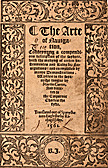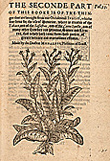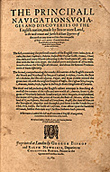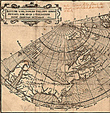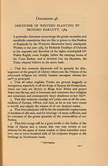Stirring up English Interest Since the time of Columbus, Spain and Portugal had established a New World presence while England had continued to focus primarily on European trade. It was not until economic depression forced a reconsideration of this traditional stance that England had need to confront the organized and well-established maritime activity of her competitors. English attention did not immediately focus on North America but on the further development of eastern markets, an economic goal that would be supported by the discovery of a practical passage through the barrier of North and South America. A major problem, however, was the lack of geographical and navigational information available in the English language to inform potential mariners, adventurers, and financial backers about New World possibilities. As a result, most English voyages in the early sixteenth century were led or guided by foreigners and patriotic Englishmen looked for ways to address this deficiency. |
||
[6] The Translators—Richard Eden, 1521?-1576 By mid-century Spanish travel accounts and navigation manuals began to appear in English translation. Stephen Borough, chief pilot for the Muscovy Company, which had been established in 1555 to expand English trading networks, visited Spain in 1558 and was impressed by the maritime expertise and organization he saw there. He persuaded the Company to support the translation into English of Martín Cortés’s official Spanish treatise on navigation. The translator was Richard Eden, who had held a post as a Treasury official and was probably an historian of the Muscovy Company as well. |
||
[7] The Translators—John Frampton, fl. 1577-1596 In 1559 John Frampton, an English merchant resident in Seville, fell into the hands of the Spanish Inquisition. Years elapsed before he was able to make his escape and return home, bankrupt and disheartened. To solve his financial problems Frampton turned privateer and raided Spanish shipping. His most effective long-term revenge, however, was the translation of six Spanish books that focused the attention of Englishmen on the wealth of the Indies that they had, by default, allowed to enrich Spain and Portugal. The Joyfull newes of the title shown here refers to the anticipated profits from the cultivation and sale of New World commodities such as the potato, sarsaparilla, and sassafras (a supposed cure-all)—a strong financial motive for Sir Walter Raleigh and others to undertake the colonization of North America. |
||
[8] The Compilers—Richard Hakluyt, ca. 1551-1616 Richard Hakluyt's major work, The Principall navigations, shown here, is so celebrated that it often overshadows his long and active role in making the literature of discovery available to his countrymen. From 1580 to his death in 1616 he was directly or indirectly responsible for twenty-eight works on geography and exploration. He cast his net widely and developed a network of scholars, publishers, and explorers in England and abroad with whom he exchanged information and ideas. |
||
[9] The Compilers—Richard Hakluyt, ca. 1551-1616 Humphrey Gilbert was granted a patent to colonize regions of America to the north of Spanish claims in Florida and Mexico, but was having difficulty raising funds. Richard Hakluyt’s Divers voyages was intended as propaganda for the venture. In order to familiarize his public with the region, Hakluyt translated original documents, provided accounts of prior English voyages to the New World, and supplied descriptions of the land from a variety of sources. The work was introduced with a preface that stated Hakluyt's views on the larger aims his country ought to pursue: (1) the revival and advancement of national glory through trade, (2) the colonization of North America as a stepping stone to Asian markets and as a place of opportunity for England’s destitute, and (3) the development of British sea power through the education of her seamen. |
||
[10] Richard Hakluyt's Colonial Design Hakluyt's Discourse was written in 1584 as a result of his association with Sir Walter Raleigh, who was making plans for a colonial establishment in North America. Addressing this work to Queen Elizabeth, Hakluyt explained how an effective English presence depended upon the solid backing of the Crown. Mass emigration, the establishment of several centers of settlement, and the creation of a multi-level society to transplant the seed of English culture were measures recommended by Hakluyt to avoid expensive and tragic failure. He also underlined the political advantage of a secure English foothold in North America to counter the Spanish menace. This was a private diplomatic document, not published during Hakluyt's lifetime, and it is difficult to assess its contemporary impact. |
||
| Exhibition prepared by Susan Danforth, Curator of Maps and Prints, John Carter Brown Library. On view in the Reading Room August to November 2007. |

 |
||||||
|---|---|---|---|---|---|---|
| France and Spain on the North American Coast
|
Stirring up English Interest
|
The Beginning of the Virginia Venture
|
A Second Chance for Jamestown
|
Settlement Encouraged
|
Virginia Commodities
|
|
